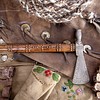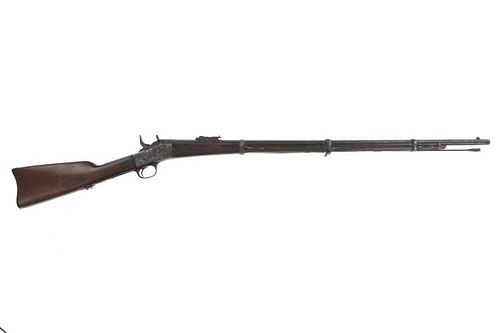The lot features a profound Remington New Model No. 1 Sporting rifle in the experimental .44-77 Sharps and Remington caliber 2 ¼ bottleneck, serial number 75293, marked “GAC” and in togia to General George Armstrong Custer, with accompanying documentation. The piece comes accompanied by a signed document from Wendell Grangaard from The Guns of History, Inc. Sioux Falls, South Dakota.
The firearm was examined by Wendell Grangaard, author and historian on Custer, the Battle of the Little Bighorn as well as the Togia language. Wendell noted the firearm being marked as such in Togia and English: On the right side stock grip is marked “GAC” above Creeping Panther and the Thunder Being protection mark (illustration 1); On the right side of the frame is marked with the protection mark of the Thunder Being above “GAC” and Creeping Panther (illustration 2); On the right side of the stock more pronounced a large protection mark of the Thunder Being (illustration 3); and on the left side of the stock a pronounced and larger Protection Mark of the Thunder Being with “GAC” at the end.
The ”Protection Mark of the Thunder Being” mark has been documented as being on the George Armstrong Custer: His Personal Army-Issue Model 1865 Spencer Carbine serial number 3658 from the Dr. Lawrence A. Frost Collection. The carbine, sold by Heritage in December 2012 for $179,250.00, was published in Frost’s 1968 book The Court-Martial of General George Armstrong Custer on page 192a (a photograph from Heritage of this page is included in the images for representation). It clearly shows what the mark that Heritage stated was original to the piece, the very same mark found on our rifle four times which shows an “M” with a line either through or coming from the “M” and having a spur like cross over. This mark is documented as being found on both our firearm and the Heritage carbine, as well as the Custer owned Remington-Rider “Big 50” No 1 Sporting Rifle 50-70 Cal S/N 10509, sold in the Little Bighorn Las Vegas auction in January 2023 for $47,500.00.
General George Armstrong Custer and the 7th Cavalry left Fort Rice on June 20, 1873, for a survey expedition for the Northern Pacific Railroad, famously referred to as the Yellowstone Expedition of 1873. Custer came across many lodges from the Hunkpapa and Minneconjou, led by Sitting Bull.
Prior to the Yellowstone Expedition, Custer had been given a rifle by the Remington Company for testing, noted by Grangaard as this New Model No. 1 Sporting Rifle by Remington in .44-77 caliber, 2 ¼ bottleneck S/N 75293 and was said to have used it during the expedition for hunting wild game and shooting at Native Americans they encountered. After Custer’s return to Fort Rice three months later, Custer wrote to the Remington Company about his experience with this rifle:
“During the three months I carried the rifle referred to on every occasion and the following list exhibits but a portion of the game killed by me: Antelope 41, buffalo 4; elk 4; blacktail deer 4; American deer 3; white wolf 2; geese, prairie chickens, and other feathered game in large numbers. The number of animals killed is not so remarkable as the distance at which the shots were executed. The average distance at which the 41 antelopes were killed was 250 yards by actual measurement. I rarely obtained a shot at an antelope under 150 yards, while the range extended from that distance up to 630 yards.”
The notable takeaway from this note is the 630-yard distance on at least one antelope kill, a distance that far surpasses the accuracy of what others thought Custer was referring to, one of Remington’s “Big 50” sporting rifles, a 50-70 cartridge. This would have been incredibly difficult if not impossible to make an accurate kill at the 630-yard distance back then with a 50-70, but very attainable with their new experimental .44-77 bottlenecked 2 ¼ inch cartridge. The .44-77 is now known as the “quintessential Buffalo rifle” cartridge.
Mo-nah-se-tah (1850-1922) aka Me-o-tzi, was the daughter of the Cheyenne chief Little Rock. Her father was killed on November 28, 1868, in the battle of Washita River when the camp of Chief Black Kettle, of which Little Rock was a member, was attached by the 7th U.S. Cavalry under the command of Lieutenant Colonel George Armstrong Custer. Mo-nah-se-tah was among the 53 Cheyenne women and children taken captive by the 7th Cavalry after the battle. According to Captain Frederick Benteen, chief of scouts Ben Clark and Cheyenne oral history, Custer cohabitated with the teenage Mo-nah-se-tah, even potentially having a child together (a fact of much debate). The following was testimony from Monahseetah:
“…Long Hair (referring to Custer) brought me to Fort Supply during the winter of 1969. I learned much from Long Hair and fell in love with him. I was his favorite. I wanted to see him again. (Later) After crossing the river, I heard the white men talking about Long Hair. I rode into the soldier’s camp, but the soldiers soon stopped me. One soldier ran to Long Hair’s tent and told him that a squaw had ridden into camp. Long Hair came out of his tent and saw me. He told me to let me come into camp, but they warned Long Hair that I had a knife. Long Hair told them to let me come. I spent one a half day with him. Before I left I took my knife and marked the stock of his rifle which was very heavy, with Cheyenne symbol so that the Thunder Being would protect Long Hair, just as I had marked his rifles at Fort Supply.”
This testimony states that Monahseetah, who was documented to be with Custer and possibly have relations with him, marked both his early rifles with the Protection Mark of the Thunder Being, and also marked this rifle.
The rifle is faintly marked with the correct Remington mark and a patent date of 1866. The rifle shows the rolling block action, the hammer clicked back twice and then the rolling block opened which both ejected the past cartridge and exposed the breech for a new round. The rifle shows an adjustable long distance site and original ram rod as well as appears to function and be complete. Under the stock, the firearm is marked with the serial number of 75293 on the frame behind the trigger guard. The rifle is also accompanied by two .44-77 Sharps & Remington Necked 2-1/4” original cartridges, as well as the signed documentation, images of Custer, pictures of the other Thunder Being marked rifles as well as a print out of “Interpreting the Brass and Other Patterns on the Custer Capture Sharps Carbine by Fred N. Holabird and R.L. Wilson (2016), which references the carbine sold by Holabird in May 2016 for $127,000 and notes Wendell Grangaard’s work interpreting the togia markings.
This is an Antique Firearm that does not require an FFL.



































